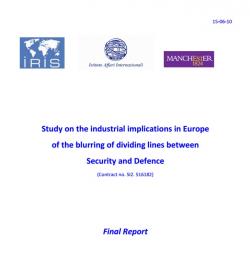Study on the industrial implications in Europe of the blurring of dividing lines between security and defence
The study, commissioned by the European Commission DG Enterprise and Industry, aims to analyze the industrial and market implications of the blurring between the concepts of Security and Defence, both at the European level and in Italy, France, Germany and the UK. The study has been coordinated by the Istituto Affari Internazionali (IAI) with partners from the Manchester Institute of Innovation Research (MIOIR) and the Institut des relations internationales et stratégiques (IRIS).
-
Details
Brussels, European Commission, 15 June 2010, 373 p.
Executive Summary
Introduction
Context
Concept
Objectives
Methodology
1. The blurring of missions between security and defence
1.1. Traditional scope of the security and defence sectors in Europe
1.2. The process of blurring between security and defence: the rise of new risks
1.3. The blurring of missions between security and defence
1.3.1. A taxonomy of current defence and security missions
1.3.2. Blurring trends within defence missions
1.3.2.1. Crisis management
1.3.2.2. Support to civil protection
1.3.3. Blurring trends within security missions
1.3.3.1. Protection against terrorism and organised crime
1.3.3.2. Border security
1.3.3.3. Critical infrastructure protection
1.3.4. Common functions in the blurred area
1.3.4.1. Detection, identification and authentication
1.3.4.2. Situation Awareness and Surveillance
1.3.4.3. Risk assessment and modelling
1.3.4.4. Communication
1.3.4.5. Information management
1.3.4.6. Positioning and localisation
1.4. Conclusions
2. Technological aspects of the blurring of dividing lines between security and defence
2.1. Technology - definition and classifications
2.2. National programmes
2.3. Identifying areas of technology blurring and the origin of technologies
2.4. Technologies with applications across defence and security missions
2.5. Specificities of technologies driving the blurring
2.5.1. Generic technologies are critical to defence and civil security applications
2.5.2. European industry has strong capabilities in some technology areas
2.6. Emerging technologies
2.7. The extent of transfer of technology from defence to security
2.8. The extent of transfer of technology from security to defence
2.9. Societal resilience
2.10. Conclusions
3. Characteristics of demand in the blurred area between security and defence
3.1. Structural differences in demand between the security and defence sectors
3.1.1. Defence demand in the blurred area between the two sectors
3.1.2. Security demand in the blurred area between the two sectors
3.1.2.1. Public security customers
3.1.2.2. Private security customers
3.2. The effect of institutions and regulations
3.2.1. Procurement rules in the defence and security sectors
3.2.1.1. Defence Procurement
3.2.1.2. Public security procurement
3.2.1.3. The EC defence package and the process for blurring
3.2.2. The role of standardisation in shaping the defence and security markets
3.2.2.1. Standardisation for defence
3.2.2.2. Standardisation for security
3.2.2.3. Standardisation for the blurred market?
3.2.3. Impact of the Lisbon Treaty
3.3. Conclusions
4. Characteristics of supply in the blurred area between the defence and security sectors
4.1. A fragmented supply base
4.2. The approach of defence origin companies in the blurred area
4.2.1. General structure of defence origin companies
4.2.2. Different approaches towards the blurred area between the sectors
4.3. The approach of security companies in the blurred area
4.3.1. Overview of security suppliers
4.3.2. Security suppliers’ approaches towards the blurred area
4.4. Technology-driven industry consolidation
4.5. Conclusions
5. Opportunities and challenges for industry
5.1. Introduction
5.1.1. The Limits of blurring
5.2. Opportunities and challenges in defence markets
5.2.1. The defence capability development processes
5.2.2. Impact on industry
5.3. Opportunities and challenges in security markets
5.3.1. Security market estimates
5.3.2. Public versus private security markets
5.3.3. Impact on industry
5.4. Conclusions
6. Recommendations
Recommendation 1: European Technology Platforms in the security domain
Recommendation 2: Promoting standardisation
Recommendation 3: Joint Calls between security and other 7th FP themes and expanded 8th FP Security Research Theme
Recommendation 4: Enhance threat and risk analysis capabilities
Recommendation 5: Establish a European Security Congress
Recommendation 6: The Commission as customer
Recommendation 6.1: Development of dual-use space systems
Recommendation 7: Strengthening coordination of research activities between the Commission, EDA and ESA
Recommendation 8: Including defence research in 8th FP
Annexes
Annex 1. List of stakeholders interviewed
Annex 2. Defence and security customers involved in blurred missions
Annex 3. Implications of Lisbon Treaty for security and defence
Annex 4. EOS, ESD and ESRIF membership
Annex 5. Country studies
Annex 5.1. Blurring between security and defence in France
Annex 5.2. Blurring between security and defence in Germany
Annex 5.3. Blurring between security and defence in Italy
Annex 5.4. Blurring between security and defence in the United Kingdom
Annex 6. The United States and the issue of blurring boundaries between security and defence



